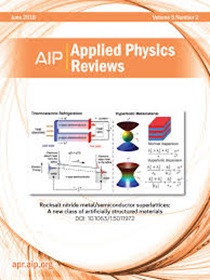用于产生量子光的体非线性超材料
IF 11.9
1区 物理与天体物理
Q1 PHYSICS, APPLIED
引用次数: 0
摘要
光的量子态,如固定光子数(Fock)态,纠缠态和压缩态,相对于经典的光态,如相干态和热态,在不同的领域提供了重要的优势:它们能够安全通信和分发加密密钥,实现具有更高灵敏度和分辨率的传感器,并且被认为是量子计算和模拟应用的候选国。为了适应这些应用,需要合适的方法来产生量子态。今天,量子态通常是由标准非线性材料中的自发非线性过程产生的,随后是在产生的光子上编码所需状态所需的一系列光学元件。在这篇综述中,我们考虑了一种构造晶体非线性的替代方法,以便在晶体上直接产生所需的量子态,而不需要额外的元素。我们主要关注的是具有二阶非线性结构的块状晶体。有效地模拟和设计自发参数下转换(SPDC)过程的能力的进步,以及通过电场极化或激光诱导写入构建铁电晶体非线性的新能力,推动了对这些非线性超材料日益增长的兴趣。因此,非线性超材料最近被用于直接塑造SPDC中产生的量子光的空间和光谱相关性。本文介绍了产生量子光的块状非线性超材料的理论背景、设计和制造方法,以及超材料在量子光学应用中的一系列演示。本文章由计算机程序翻译,如有差异,请以英文原文为准。
Bulk nonlinear metamaterials for generation of quantum light
Quantum states of light, such as fixed photon number (Fock) states, entangled states, and squeezed states, offer important advantages with respect to classical states of light, such as coherent states and thermal states, in different areas: they enable secure communication and distribution of encryption keys, enable realization of sensors with higher sensitivity and resolution, and are considered candidates for quantum computing and simulation applications. To accommodate these applications, suitable methods for generating the quantum states are needed. Today, the quantum states are often produced by a spontaneous nonlinear process in a standard nonlinear material, followed by a series of optical elements necessary for encoding the desired state on the generated photons. In this review, we consider an alternative approach of structuring the nonlinearity of the crystal so that the desired quantum state will be generated directly at the crystal, without the need for additional elements. Our main focus here is on bulk crystals having structured second-order nonlinearity. The rising interest in these nonlinear metamaterials is fueled by advancements in the ability to efficiently simulate and design spontaneous parametric downconversion (SPDC) processes, as well as by new capabilities of structuring the nonlinearity of ferroelectric crystals, either by electric field poling or by laser-induced writing. As a result, nonlinear metamaterials were recently used to directly shape the spatial and spectral correlations of quantum light that is generated in SPDC. The paper covers the theoretical background and the design and fabrication methods of bulk nonlinear metamaterials for generating quantum light, as well as a series of demonstrations of the use of metamaterials in quantum optical applications.
求助全文
通过发布文献求助,成功后即可免费获取论文全文。
去求助
来源期刊

Applied physics reviews
PHYSICS, APPLIED-
CiteScore
22.50
自引率
2.00%
发文量
113
审稿时长
2 months
期刊介绍:
Applied Physics Reviews (APR) is a journal featuring articles on critical topics in experimental or theoretical research in applied physics and applications of physics to other scientific and engineering branches. The publication includes two main types of articles:
Original Research: These articles report on high-quality, novel research studies that are of significant interest to the applied physics community.
Reviews: Review articles in APR can either be authoritative and comprehensive assessments of established areas of applied physics or short, timely reviews of recent advances in established fields or emerging areas of applied physics.
 求助内容:
求助内容: 应助结果提醒方式:
应助结果提醒方式:


